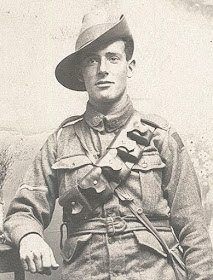Image
from Coburg State School Soldiers Book. Courtesy Coburg Historical Society.
Thomas
Boyd, an old boy of Coburg State School, was born in Ararat in 1891. His Irish
parents John Wilson and Caroline Boyd married in Melbourne in 1889 and their
first four children were born at Ararat. Two more children were born once the
family had moved to Coburg – a sister in 1900 and a brother in 1905. The Boyds
lived at 1 Blair St., Coburg and father John was a warder at Pentridge Prison.
At
six foot tall and with previous experience in the infantry and senior cadets,
Thomas Boyd must have been seen as an ideal candidate for the military. He was
a gas fitter with the Metropolitan Gas Company and enlisted on 20 August 1914,
one of the first men in the area to do so.
He left with the first contingent in
October 1914 and landed at Gallipoli on 25 April 1915 with the 2nd Field
Company Engineers. He was there for three months before being hospitalised in
Alexandria with severe rheumatoid fever.
The Field Engineers were
responsible for building and destroying bridges, roads and other
infrastructure and local newspapers reported that on Gallipoli Thomas Boyd was
involved in an accident while building a bomb shelter. Several sandbags from
the bomb shelter fell on him and while being carried on a stretcher to get
medical care, he was shot.
At the same time he was diagnosed with rheumatic
fever and placed on the dangerously ill list. He was removed from the list in
August 1915 and transferred to England where his health further deteriorated.
Although he improved again, he was returned to Australia in April 1916 and
discharged as medically unfit after several months at Langwarrin Isolation
Camp.
This
was not the end of Thomas Boyd’s war, however. He re-enlisted in December 1916 and again embarked for overseas
service in early May 1917. He arrived in
Egypt in June 1917, but again his health let him down and in December 1918 he
was admitted to hospital in England with pneumonia and suspected pulmonary
tuberculosis. His health improved and he arrived in France with his unit in
February 1918. However, a month later he was gassed and on the sick list again until
August 1918, when he rejoined his unit. At the end of October 1918 he was sent
to hospital with suspected pulmonary tuberculosis and returned to Australia not
long afterwards with bronchitis and influenza.
In 1920 Thomas Boyd married Rachel
Cuthbert and they settled in Alice Street, Coburg. He joined the police force. Throughout
the 1930s and 1940s he worked with Traffic Branch, was promoted to first class
sergeant and by the 1950s, when he was in his late 50s, he was Officer in Charge of the
Police Transport Branch.
Thomas
Boyd died at Heidelberg on Boxing Day 1974 aged 83. He is buried at Coburg
Cemetery with his wife Rachel, who predeceased him.








